Swifts and Hummingbirds of Maricopa County
Vaux's Swift Chaetura vauxi
The Vaux's Swift is a small swift that summers in old-growth forests in the western Pacific States, and is usually found near water, where it likes to catch insects. It catches insects in midair and nests in cavities of dead snags. This swift is a sooty brown color overall, and has a pale-gray throat and upper breast. Vaux's Swifts and the similar Chimney Swift almost look like "cigars with long pointed wings" in flight. In Maricopa County, the Vaux's Swift is only a spring and fall migrant. It isn't seen often in spring migration, but fall migration it is seen regularly, especially in the month of September. Vaux's Swifts are seen best by simply looking up in the sky during this time, and are sometimes seen flying with swallows, or over migration routes such as rivers.
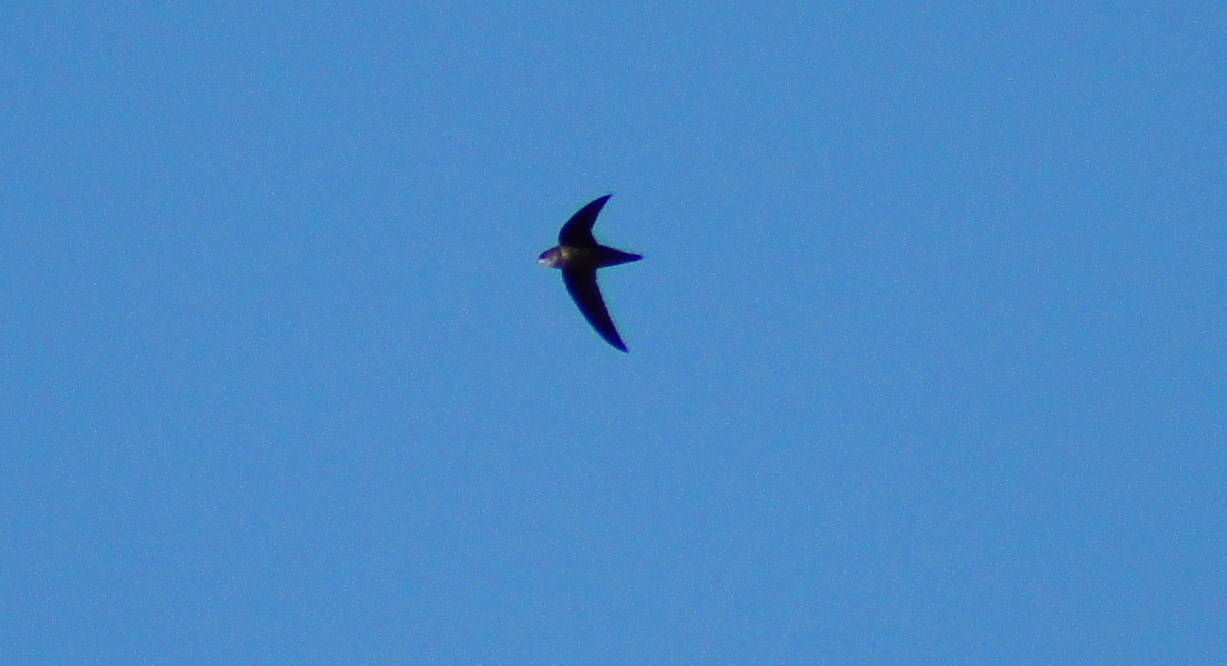
White-throated Swift Aeronautes saxatalis
This spectacular black-and-white flyer makes it's home up high in cliffs, mountains, and canyons in a variety of surrounding habitats in western North America (mainly Lower 48). The White-throated Swift nests in colonies, and builds it's nest high in crevices on canyon and cliff walls, and the well placed nest is inaccessible to any potential predators. This swift is very vocal, and it's voice often echoes across the canyon and cliff walls. In flight, the White-throated Swift catches a variety of flying insects in midair. White-throated Swifts may also be found in the middle of cities where they may favor tall buildings. This swift is also one of the fastest flying birds in North America, where it's flight consists of high speed soaring and gliding as it darts and changes direction constantly. In Maricopa County, White-throated Swifts are found in places with cliffs or tall canyons year round, especially in deserts. Excellent places to view this amazing flyer in the county include: Area 2 (Goldfield and Saguaro Lake Recreation Sites), much of Area 3, Area 5 (South Mountain Park), Area 6 (Phoenix Mountains Preserve), Area 9 (White Tank Mountains Regional Park), Area 10 (Castle Hot Springs Road)
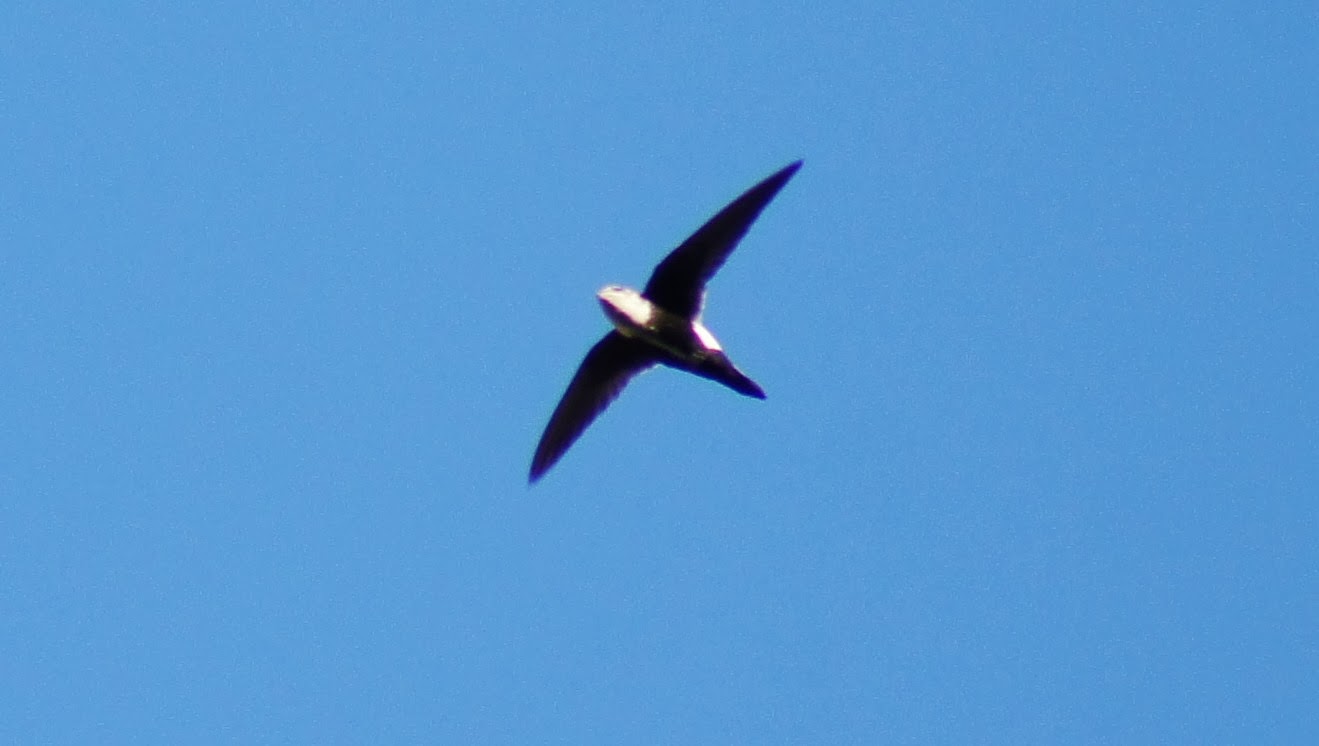
Black-chinned Hummingbird Archilochus alexandri
The Black-chinned Hummingbird frequents much of the west, where it's preferred habitats are a variety of woodlands, washes, foothills, and gardens. In the west, the Black-chinned Hummingbird has the largest breeding range of any western hummingbird. It feeds on nectar, pollen, and insects, and likes to visit feeders with sugar water. In Maricopa County, Black-chinned Hummingbirds are found most easily in riparian habitats. This hummingbird arrives in Arizona near the beginning of March, where it can be found through September before migrating south again.
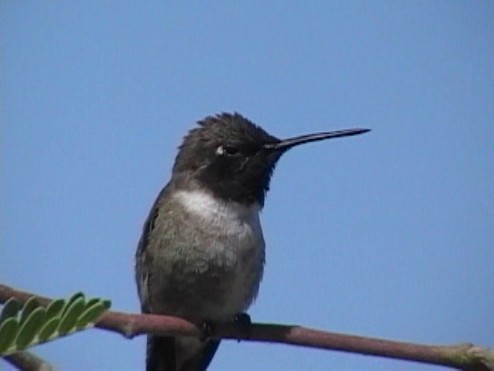
Anna's Hummingbird Calypte anna
The Anna's Hummingbird is a highly vocal hummingbird, often singing throughout the day. This hummingbird is increasing it's range, and is adapted to a variety of habitats. It's North American range consists of much of Arizona, and the Pacific Coast states of California, Oregon, and Washington. It's main habitats throughout it's range consist strongly of deserts, as well as coastal lowlands and mountains. The male Anna's Hummingbird has a rosy red head and throat, which is distinctive among North American hummingbirds. This guy has an interesting courtship display he puts on for a female, making an Abert's Towhee like call-note at the bottom of his display dive after dropping from over 100 feet and going in high speeds. The diet of the Anna's Hummingbird is rather variable, as it eats a variety of insects and spiders as well as nectar and coming to hummingbird feeders. This hummingbird is a permanent resident in most of it's range, although it may move up and down from higher elevations during the year. In Maricopa County, the Anna's Hummingbird is viewed the most out of the other hummingbird species and is found in a variety of habitats. Habitats include any desert, riparian area, dry foothills, and even pine and oak forests in Transition Zones. Anna's Hummingbirds also survive well near people, and are also very common in suburban areas in the middle of the city. This hummingbird is found easily in any area in the county.
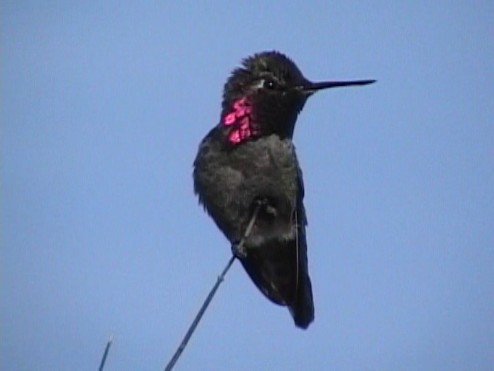
Costa's Hummingbird Calypte costae
This tiny hummingbird is the second smallest bird in North America, only larger than the Calliope Hummingbird. The Costa's Hummingbird is found in North America strictly in the desert southwest. The male Costa's Hummingbird gives a distinctive "wwhheeeooo" high and buzzy callnote, which rises and falls in pitch. Costa's Hummingbirds are identified rather easily by their small size and short wing and tail length, which are almost even with their tail when perched, although they barely project beyond the tail tip. The diet of the Costa's Hummingbird consists of nectar, insects and spiders, and sugar water from feeders. Female Costa's Hummingbirds raise young alone near the male's territory. The Costa's Hummmingbird is found throughout most of the year in it's preferred habitats, although most of the population migrates south during the warmer summer months of the year to avoid the heat. This means it breeds very early in the winter months in it's favored desert habitats, where it is observed most easily. With the extreme seasons of heat being out of the way, the Costa's comes back to the desert to have their say. This hummer is found throughout many areas in Maricopa County, which some include: Area 1 (Mesquite Wash, Sycamore Creek), Area 2 (Phon D. Sutton, Blue Point, Saguaro Lake, and Butcher Jones Recreation Sites), most of Area 3, Area 5 (South Mountain Park, Desert Botanical Garden), Area 6 (Thunderbird Conservation Park, Thunderbird Viewing Blinds Park, Phoenix Mountains Preserve), Area 9 (White Tank Mountain Regional Park), Area 10 (Morgan City Wash, Lake Pleasant Regional Park), Area 11 (Spur Cross Conservation Area, Rackensack Canyon), and Area 12 (Box Bar and Needle Rock Recreation Areas in desert habitats, Bartlett Lake Recreation Area).
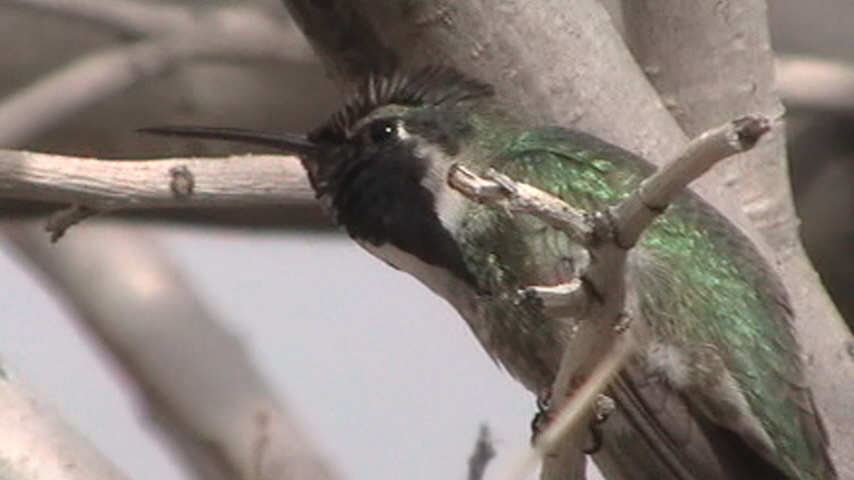
Broad-tailed Hummingbird Selasphorus platycercus
The Broad-tailed Hummingbird favors higher elevations and is found in mountain forests and meadows of the west. The male Broad-tailed Hummingbird has a unique and high-pitched trill given in flight, which is created by the air moving through it's primary feathers. This sound helps the male, who is very aggressive, defend his territory against other Broad-tailed Hummingbirds. The diet of this hummingbird consists of nectar, insects, spiders, and tree sap, and it also comes to feeders to feed on sugar water. In Maricopa County, Broad-tailed Hummingbirds are found breeding in the county in the pine and oak forests of Mount Ord, Slate Creek Divide, and Four Peaks Wilderness (Area 1). They are present usually from April through August. Broad-tailed Hummingbirds are also seen fairly often in spring and fall migrations during the lowlands, although migrant numbers are much higher in the higer elevations in the county.
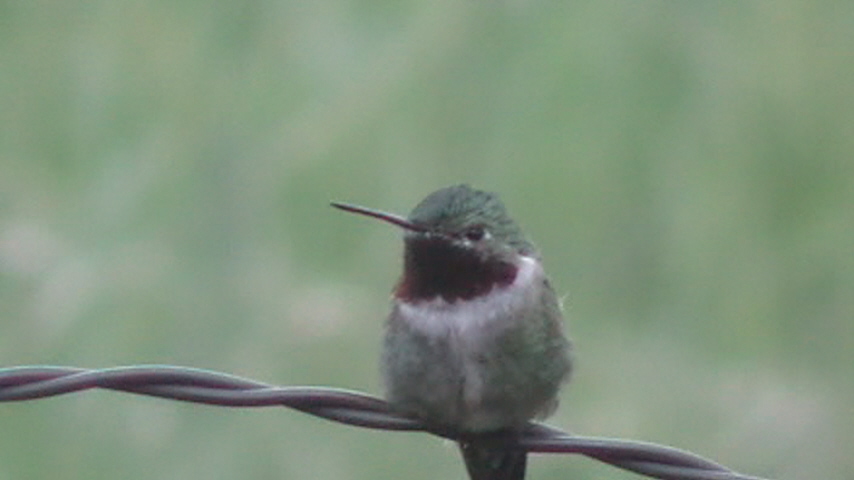
Rufous Hummingbird Selasphorus rufus
The Rufous Hummingbird has a bad temper and is very competitive. It is very defensive of it's territory and drives away hummingbirds, and other birds and even animals away. When it comes to feeders, it spends most of it's time driving other hummingbirds away. The Rufous Hummingbird is well named, and is colored rufous throughout it's body, as it is the only North American hummingbird with a rufous back. This bird nests in the northwestern part of the United States, western Canada, and southern Alaska. Besides nectar and insects, the Rufous Hummingbird feeds on leftover sap from drilled woodpecker holes when not coming to hummingbird feeders. In migration, the Rufous Hummingbird is abundant and common, especially during fall migration in high elevation meadows. Northern Arizona is a great place to view Rufous Hummingbirds in migration. In Maricopa County, Rufous Hummingbirds are fairly common during both migrations, and are seen more often in fall. They are seen especially in riparian areas, foothills, and Transition Zones.
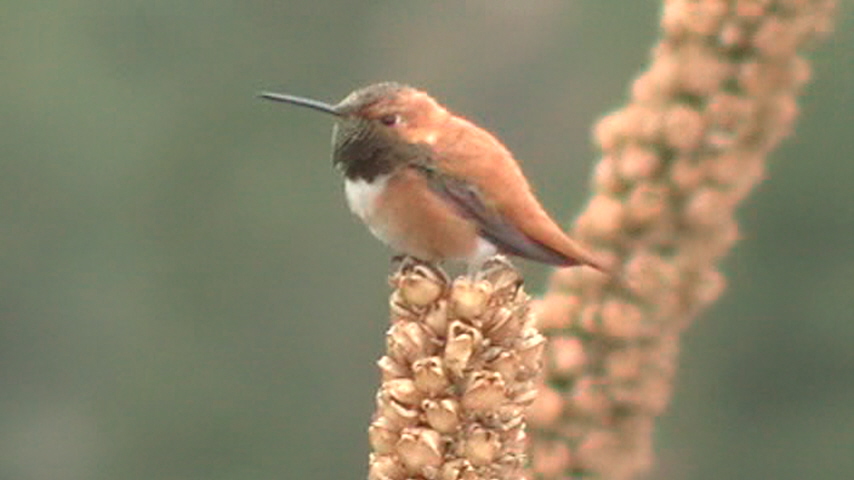
Also keep an eye out for....
Calliope Hummingbird Stellula calliope
This tiny hummingbird is the smallest bird in North America. It breeds in high elevations in northern forests and meadows, and have a hard time competing against other hummingbirds for food source due to it's tiny size. The Calliope Hummingbird feeds on insects, sap, nectar, and sugar water from visiting hummingbird feeders regularly. This bird is a strong survivor of the north, finding ways to survive the coldest nights, despite it's tiny size. Calliope Hummingbirds are found breeding in the western United States and southern Canada in their breeding range. These birds have different routes in spring and fall migrations. In fall migration, the Calliope Hummingbird is uncommon to common in Arizona, and is rare in spring, and mainly passes through the higher elevations of central, southern, and northeastern Arizona. Calliopes are rarely found in Maricopa County, but based on migration patterns, they are likely very annual in the higher elevations in Maricopa County where there are Transition Zones (Area 1). Keep an eye out for this bird when birding at locations of higher elevations such as Mount Ord, Slate Creek Divide, and Four Peaks Wilderness.
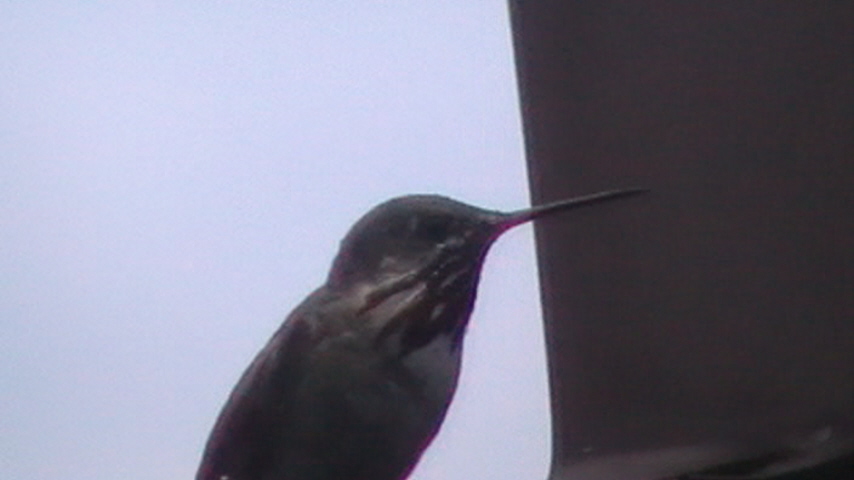
Broad-billed Hummingbird Cynanthus latirostris
The beautiful Broad-billed Hummingbird reaches North America mainly in the limits of southeastern Arizona but is also found in small parts of New Mexico and Texas. In southeastern Arizona, it resides in desert areas, riparian areas, canyons, as well as oak and pine woodlands, where it is common. It has a distinctive series of callnotes, which sounds similar in tone to the callnote of a Ruby-crowned Kinglet. Feeders with sugar water commonly host the Broad-billed Hummingbird, who also has a diet of insects and nectar. Broad-billed Hummingbirds also commonly wander out of their normal range, and have shown up in states as far east as Massachusetts. They show up in central Arizona annually, and have a small breeding population at Boyce Thompson Arboretum near Globe in Pinal County. In Maricopa County, the Broad-billed Hummingbird is found annually with a scattering of records, usually in riparian areas, and sometimes coming to hummingbird feeders. An adult female with a juvenile bird at the Baseline and Meridian Wildife Area in 2009 likely suggested breeding for the first time in Maricopa County. Be sure to keep eyes and ears out for this species in Maricopa as it is increasing it's range, especially in riparian woodlands.
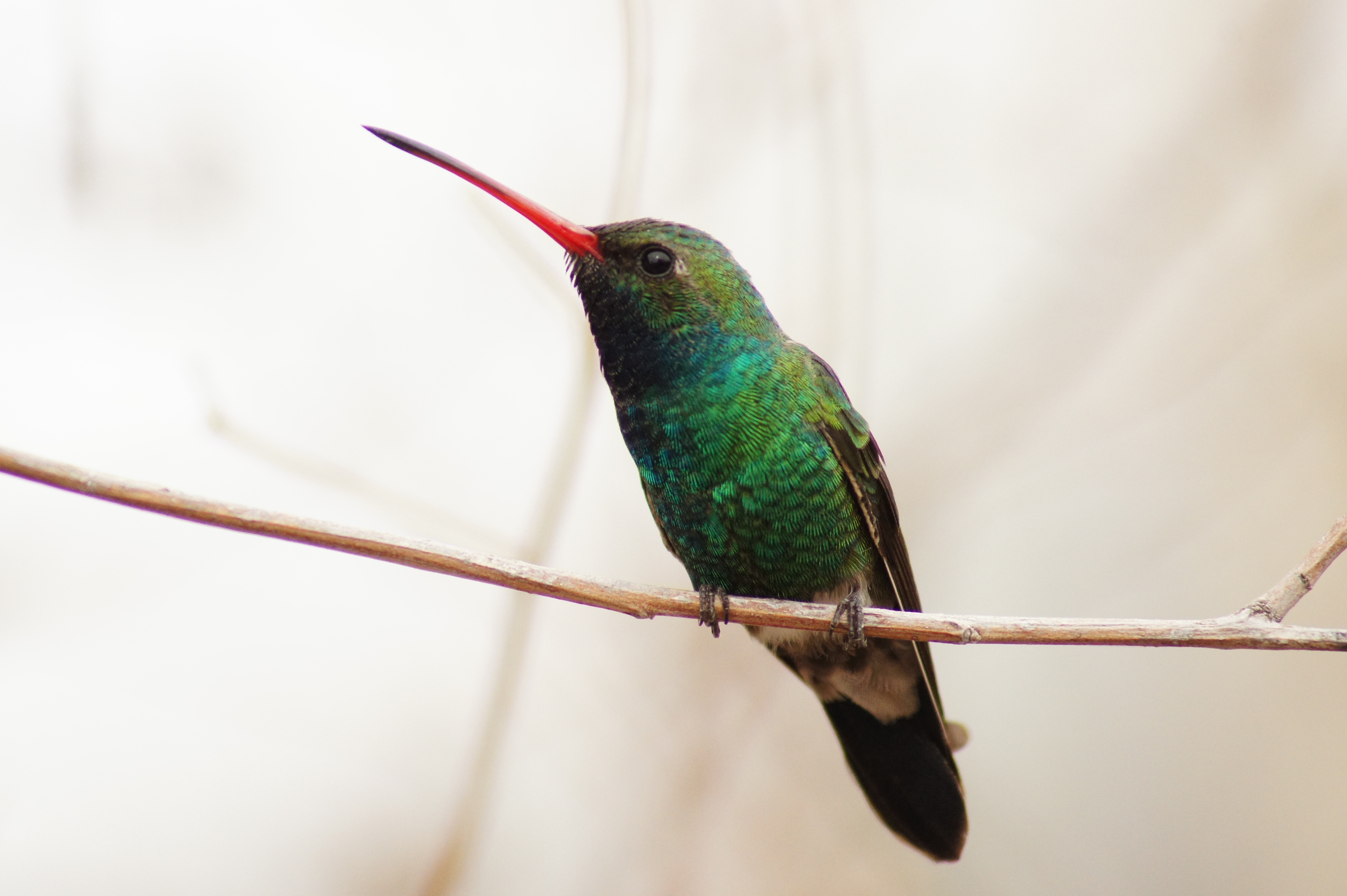
Back to What Bird Are You After? main page. |
